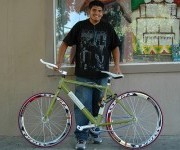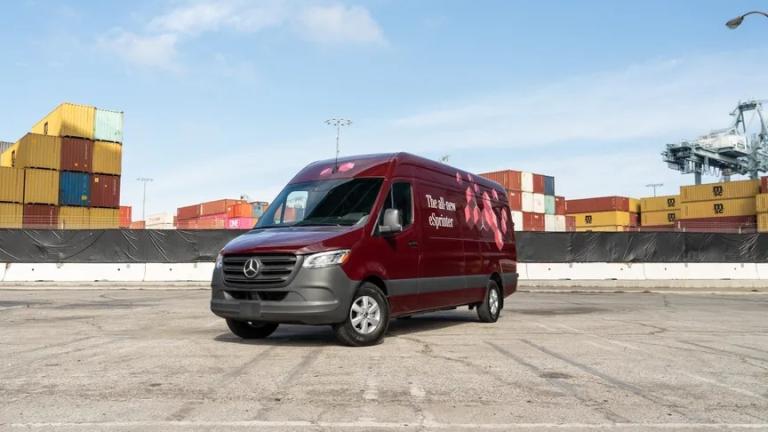A young cyclist in San Jose.Photo: Elly Blue
Elly Blue is on a monthlong Dinner & Bikes tour around the western U.S., along with Portland bike filmmaker Joe Biel and traveling vegan chef Joshua Ploeg. This is one of her thrice-weekly dispatches from the road about bicycle culture and economy. Read them all here.
San Jose, Calif.: We spent Wednesday night in San Jose, in the heart of Silicon Valley. This is the promised land of the tech startup, home to high-rise glass towers packed with nerdy white guys in collared shirts hunched over laptops writing code, cheek-to-cheek with staggering poverty, police brutality, and a giant suburban mess. The largest city in Northern California grew up fast, and isn’t known for bike-friendly streets. We quickly learned why.
We saw only a few people on bikes as we clumsily navigated a maze of four-lane arterials while looking for a grocery store. Several men decked out in Lycra and fluorescent yellow zoomed past. A shirtless guy whipped around the corner on the wrong side of the street. An older white woman in flowing earth tones with a basket on her bike stopped to stare. Young Latino men riding mountain bikes on the sidewalk gave us friendly nods as we cruised by. We’re a bit of a spectacle in our packed rental car piled with bikes, looking every bit like the vehicles we’ve seen emerging from Burning Man all week, except for the requisite thick coating of white dust.
Though it now has a population of over a million, San Jose started small. And it started bikey.
“We do have a velodrome here,” volunteered a man in the audience after the dead silence that greeted my question about the local bike economy. Diane Solomon, a local public radio personality, chimed in to explain that in the late 1800s, bikes were all the rage in this town.
“What happened?” I asked.
“Baseball,” she said. “It became the all-American pastime instead.”
More than sporting trends have changed in the past century. “This is a town of agriculture that’s sprung into being nothing but engineers,” said Carlos Babcock, who organized our event. I’d met “Carless Carlos” at the Towards Carfree Cities conference in Portland, Ore. in 2008. Since then, he’d worked for the Silicon Valley Bicycle Coalition and is now researching a book about carless transportation in the Bay Area. It takes him two and a half hours to get to the research library in Berkeley using transit, he said — over twice as long as it might take to drive, because there are no direct trains.
Babcock coordinates media relations for the Bike Party, a monthly nighttime ride that boasts 3,500 to 4,000 participants in summer months, he told me, and “in January when it’s raining, more like 300, just the core people.” I gaped at this number. He shrugged. Everything in San Jose seems larger than life, even its bike events. For example, with the help of a local toy shop owner and a city councilor, Babcock started a monthly Kidical Mass ride earlier this year, but he wanted to keep it small, so “it’s only 60 or 70 people so far.”
Monthly Bike Parties have been going on for four years, and now have expanded to cities all around the Bay so that there’s a ride in the area every weekend of the year. It’s a spin-off of Critical Mass, but with a twist. Instead of forming a unified, autonomous swarm of bicycles sweeping across the city, Bike Party riders stick to the right lane of multi-lane streets and stop to wait for red lights. As a result, riders get spread out over many miles, so there are several set regrouping points, often featuring DJs and costume theme parties. The dozen food trucks that follow the event and make bank at all the regrouping points add an economic element to the party.
Bike Party is clearly the core of San Jose’s organized bike culture. It’s used as an opportunity to network, to educate new riders about safe and legal riding practices, to ride safely en masse on streets that are more dangerous to navigate alone and during the day, and to get together and socialize in a sprawling city with a notoriously rough bar culture.
Access to bike culture, camaraderie, and leadership are clearly major benefits of the Bike Party. But, I wondered the next day, is it subject to the same class and cultural divisions that mark this city of contrasts?
San Jose’s gaping class divide is evident as much in the bike scene as anywhere. Our event was held at the Silicon Valley De-Bug, a community arts space that also houses the city’s main civil rights group, which mobilized thousands to march successfully for assembly line workers’ rights. When we arrived to set up, our pale skin and non-teenager status put us in a distinct minority, but by the time our event started the group that had assembled was mostly white, though there was a mix of ages and genders, including several families with young kids. “It was a lot of Bike Party people there,” said Jo, the young teacher and one of the Bike Party’s founders, in whose living room we’d slept that night.
I asked Jo what the demographic mix is on bikes in San Jose. It’s a lot of commuters, she said: There are people going to tech jobs, where showers and changing rooms encourage bicycling to work. Others commute to manual labor jobs, she said, and you often can tell they don’t have the same access to bicycle outreach and advocacy.
One potential way across this divide lies in the Bike Party’s approach to gender.
“Sometimes we call this place Man Jose,” said Babcock. The tech world consists largely of male-dominated professions — programmers and engineers. “You go to the coffee shop at 9 a.m. and it’s all white men on laptops, coding,” Babcock explained, pulling out his phone to prove the point with a photo. So, naturally, “Bike Party at first was very male-oriented. Then they started doing these ladies’ rides” every few months, resulting in more women participating in general but also taking on leadership roles. “As more women got into it you’re seeing a lot more of a mix.”
San Jose’s bike culture exists in the face of, if not despite, its car-centric backdrop. The status quo is strong and the scales aren’t exactly balanced — a planned freeway expansion project in the works, said Jo, is intended to serve weekend traffic to a giant upscale mall. But being on their own means that bicycle society is entirely what the people make of it — and it’s growing into a powerful civic force.
If the people demand it, San Jose could change gears to become a truly bicycle friendly city. If they work together across the wealth di
vide, it could be the first truly equitable one.


